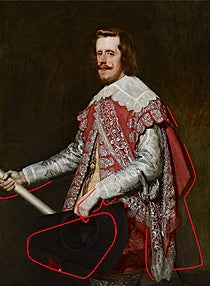The King at War: Velázquez's Portrait of Philip IV
October 26, 2010, through January 23, 2011
Recent Conservation
Conservation treatment of Velázquez’s King Philip IV of Spain in 2009 created an opportunity for in-depth technical study, and a number of interesting discoveries were made. The picture is remarkably well preserved and was treated to replace a layer of varnish that had become discolored over time. The original colors of the portrait and Velázquez’s painting technique can now be fully appreciated.
| |
 |
| |
Pentimenti in King Philip IV of Spain |
Velázquez made several changes (called pentimenti) as he painted, some of which are visible to the naked eye. The hat was initially in a lower position and slanted across the king’s body; the red underlayer is visible next to the king’s knuckle. The proper left hand and the sleeve had to be adjusted accordingly and were repainted overlapping the yellowish buckskin jerkin. The right contour of the coat was originally painted flaring out, creating a bell-like form. Later, Velázquez decided to make the outline more interesting by covering a large area of the red coat with the background color. The sword was slightly lowered at that stage; the coat was expanded a little on the left, and the part of the sash that hangs from the sword was made narrower. These alterations create a more pleasing composition, emphasizing dignity and formal control, although it is also possible that some of the adjustments record changes of position in the different sittings.
| |
 |
| |
Workshop of Velázquez, copy ofKing Philip IV of Spain, c. 1644
(London, private collection) |
The canvas seems to have been cut along the top edge and even more so along the bottom. Radiography revealed the “ghost image” of the center bar of the original strainer about an inch below the middle of the painting, suggesting that about one inch was cropped off the bottom edge. This conjecture is confirmed by a copy of the painting in its original state made in Velázquez’s workshop, which has a slightly longer vertical dimension. The original composition must have shown the lacy fringe on the top of the king’s knee-high boots, some of which is in fact visible along the bottom edge of the Frick painting.
At some point in the eighteenth century, or perhaps earlier, the picture was expanded by adding strips of canvas to the sides (fig. 1, below left). A red earth ground layer was applied to these strips and clumsily spread over onto the edges of the original composition (fig. 2, below right). Later, the additional strips were removed, and the perimeter of the original painted surface was used as the tacking edge, to fix the canvas to the strainer. Finally, at a later stage, the painting was relined (glued onto a new canvas for support), and the tacking edges were turned out and flattened in an attempt to restore the painting to its original dimensions.
 |
| Fig. 1 |
Fig. 2 |
| Alterations made to King Philip IV of Spain after it was painted. |
| |
| The exhibition is made possible by The Andrew W. Mellon Foundation |
|


